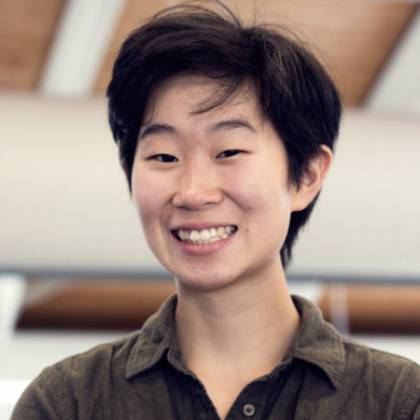A lifelong artist who came to science through her design work, Katherine Xiang spent her Hopkins career leveraging her talents in the scientific world, curating gallery exhibitions with the TedX team, collaborating with a local Baltimore artist on a stage installation inspired by entropy, and designing graphics about GMO misinformation for the meal-replacement company Soylent.

After finishing her final semester at Hopkins, Xiang—a physics, biophysics, and mathematics major—was awarded the Hertz Graduate Fellowship, a prestigious award recognizing her contributions to physics.
The fellowship is granted to outstanding physical, biological, and engineering science students who demonstrate the potential to change the world for the better through their research. Xiang is one of 16 students selected to receive the award from a pool of more than 800 applicants. The award includes up to five years of funding, as well as professional support from a network of more than 1,200 fellows.
While Xiang may have originally felt her scientific and artistic leanings were at odds with each other, she realized their intrinsic link during the summer before college.
"One day I applied to a job at a science infographic startup on a hopeful whim. This led to a surprise—my first encounter with research," Xiang said. "One morning, I got a phone call from the CEO. He was delighted by my graphic design work and wanted me to work for them. However, I had never read a research paper before."
The intersection of science and design will play a major role in her career in physics, during which she hopes to leverage her artistic talents to merge her research with communication, delivering findings to the public with integrity.
"I am confident that scientific progress will better people's lives, and I strive toward inspiring this same belief in the public, by explaining science through an accessible medium," Xiang said. "The U.S. needs science communication now more than ever in this era of scientific distrust, such as toward climate change, immunology, GMOs, and other fields. Science communication will certainly not be enough, but it's a first step."
While at Hopkins, Xiang worked extensively with the Reich Research Group. Daniel Reich, principal investigator of the group, described Xiang as the best undergraduate research student he ever worked with.
"She has outstanding experimental and mathematical skills, and has an overwhelming perseverance and commitment to get things done in the lab," Reich said. "She took our research on the dynamics of force fluctuations in the cellular cytoskeleton in a new direction, and her work forms a major component of two papers that we expect to publish this year."
With support from the fellowship, Xiang will pursue a PhD in physics at Harvard University in the fall. Although she is keeping her options open, her possible paths for research at Harvard are plentiful: quantum mechanics, magnetic field sensing in birds, and innovative treatments for metabolic diseases. She hopes to continue to hone her creative abilities through art classes and continue to merge the two in her career as a scientist to make the results of her work more accessible.
Students interested in applying for the Hertz Graduate Fellowship can find information and support at the National Fellowships Program website.
Posted in Science+Technology
Tagged scholarships








